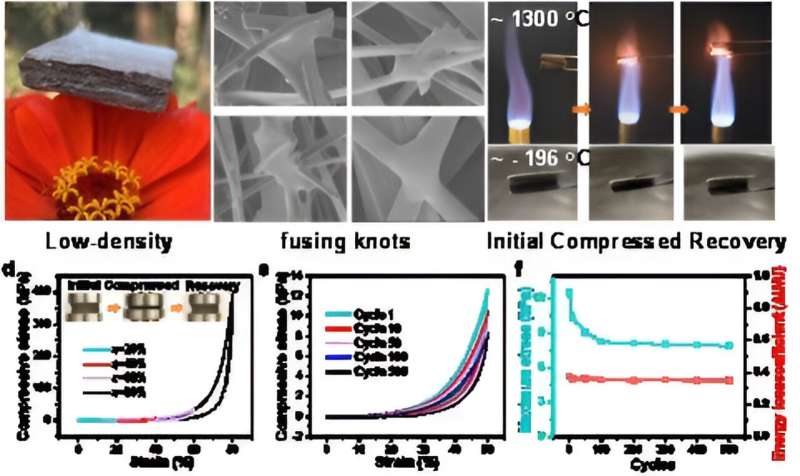
A research group led by Prof. Wang Zhenyang and Zhang Shudong from the Hefei Institutes of Physical Science of the Chinese Academy of Sciences, has developed synergistic aerogel materials with high temperature resistance, mechanical strength and thermal insulation performance.
The research is published in ACS Applied Materials & Interfaces.
Inorganic SiO2 aerogel is a porous solid material which is self-assembled by silica nanoparticles. Its abundant particle pores are filled with air, which gives it the characteristics of low volume density, high porosity and low thermal conductivity. It is considered to be the solid material with the lowest thermal conductivity, and has become one of the most critical insulation materials in high-end thermal control fields.
However, the structural brittleness and low temperature resistance (≤700°C) of inorganic SiO2 aerogel limit its service application in extreme environments.
In this study, the researchers tackled these limitations by introducing a small amount of ZrO2 crystalline phase to one-dimensional SiO2 fibers, significantly enhancing their temperature resistance. They also created multiple fusion nodes between the SiO2 fibers to improve compressive strength and fracture toughness.
The resulting aerogel has a thermal conductivity as low as 0.092 W/m·K, an elastic strain of over 80%, and a compressive strength of 389 kPa. It also maintains stability and elasticity across a wide temperature range from -196°C to 1,300°C.

They also explored two-dimensional inorganic aerogels, which were formed by assembling nanosheets into a porous solid structure. By using montmorillonite nanosheets and hydroxyapatite nanowires, they created a two-dimensional aerogel with excellent thermal insulation and flame retardant properties. This material demonstrated a compression modulus of 80 MPa in standard tests.
In addition, the team investigated biomass aerogels for use as eco-friendly building insulation materials. They developed new cross-linking methods to improve the flame retardancy and mechanical properties of these aerogels. Notably, they developed biomass sodium alginate aerogels that can support more than 2,600 times their own weight and possess excellent flame retardancy and self-extinguishing properties.
This research not only overcomes the challenges of balancing high temperature resistance and strength in aerogels but also provides new materials for efficient heat insulation, fire prevention, and mechanical stability under extreme conditions.
More information:
Yang Chen et al, Interpenetrated Multinetwork Hybrid Aerogels by Layered Montmorillonite and One-Dimensional Hydroxyapatite Fibers for Heat and Fire Insulation, ACS Applied Materials & Interfaces (2024). DOI: 10.1021/acsami.4c08796
Citation:
Synergistic aerogel materials developed for heat and fire insulation (2024, August 2)
retrieved 4 August 2024
from https://phys.org/news/2024-08-synergistic-aerogel-materials-insulation.html
This document is subject to copyright. Apart from any fair dealing for the purpose of private study or research, no
part may be reproduced without the written permission. The content is provided for information purposes only.

